THE LIVING WORLD
Unit Seven. Plant Life
34. Plant Reproduction and Growth
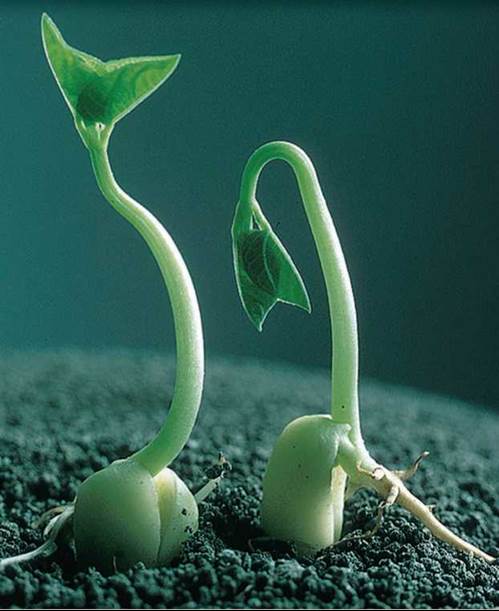
Seeds are one of the cleverest adaptations of plants. Carried by wind or animals, they are capable of transporting the next generation to distant locations and so ensuring the plant an opportunity to occupy any available habitats. A seed is a protected package of genetic information, an embryonic individual kept in a dormant state by a variety of mechanisms, such as a watertight covering that keeps the seed’s interior free of water. When the seed is deposited in suitable soil, the watertight covering splits open and the embryo begins to grow, a process called germination. These seeds of a soybean plant are germinating, with leaves thrusting upward and roots downward toward the soil. For many seeds, moisture and moderate temperatures are sufficient to trigger germination. For some seeds, however, more extreme cues are required. The seeds of many species of pine tree, for example, will not germinate unless exposed to extreme temperatures of the sort experienced in forest fires; periodic forest fires provide openings for sunlight to reach the seedlings, and abundant nutrients enter the soil from the tissues of fire-killed trees.
34.1. Angiosperm Reproduction
Although reproduction varies greatly among the members of the plant kingdom, we focus in this chapter on reproduction among flowering plants. While the evolution of their unique sexual reproductive features, flowers and fruits, have contributed to their success, angiosperms also reproduce asexually.
Asexual Reproduction
In asexual reproduction, an individual inherits all of its chromosomes from a single parent and is, therefore, genetically identical to that parent. Asexual reproduction produces a “clone” of the parent.
In a stable environment, asexual reproduction may prove more advantageous than sexual reproduction because it allows individuals to reproduce with a lower investment of energy and maintain successful traits. A common type of asexual reproduction, called vegetative reproduction, results when new individuals are simply cloned from parts of the parent.
Vegetative reproduction in plants varies:
Runners. Some plants reproduce by means of runners—long, slender stems that grow along the surface of the soil. The strawberry plant shown here reproduces by runners. Notice that at node regions on the stem, adventitious roots form, extending into the soil. Leaves and flowers form, and a new shoot is sent out, continuing the runner.
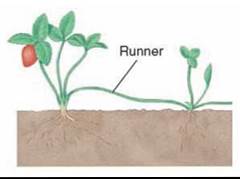
Rhizomes. Rhizomes are underground horizontal stems that create a network underground. As in runners, nodes Rhizome give rise to new flowering shoots. The noxious character of many weeds results from this type of growth pattern, but so do grasses and many garden plants such as irises. Other specialized stems, called tubers, function in food storage and reproduction. White potatoes are specialized underground stems that store food, and the “eyes” give rise to new plants.
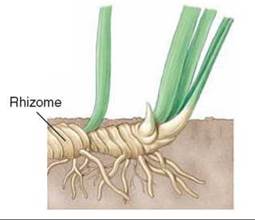
Suckers. The roots of some plants produce “suckers,” or sprouts, that give rise to new plants, such as found in cherry, apple, raspberry, and blackberry plants. When the root of a dandelion is broken, which may occur if one tries to pull it from the ground, each root fragment may give rise to a new plant.
Adventitious Plantlets. In a few species, even the leaves are reproductive. One example is the house plant Kalanchoe daigremontiana, familiar to many people as the “maternity plant,” or “mother of thousands.” The common names of this plant are based on the fact that numerous plantlets arise from meristematic tissue located in notches leaves, as you can see in the photo shown here. The maternity plant is ordinarily propagated by means of these small plants, which drop to the soil and take root when they mature.
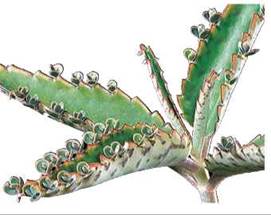
Sexual Reproduction
Plant sexual life cycles are characterized by an alternation of generations, in which a diploid sporophyte generation gives rise to a haploid gametophyte generation, as described in chapter 32. In angiosperms, the developing gametophyte generation is completely enclosed within the tissues of the parent sporophyte. The male gametophytes are pollen grains, and they develop from microspores. The female gametophyte is the embryo sac, which develops from a megaspore. Microspores and megaspores are discussed further on the following pages. Pollen grains and the embryo sac both areproduced in separate, specialized structures of the angiosperm flower. The pollen grains form on filaments that extend out from the flower, and the embryo sac sits at the base of the flower, as shown below.
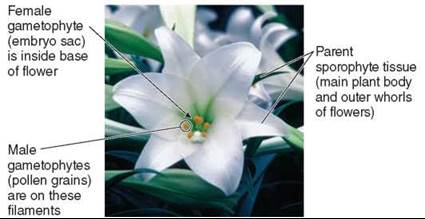
Key Learning Outcome 34.1. Reproduction in angiosperms involves asexual and sexual reproduction.